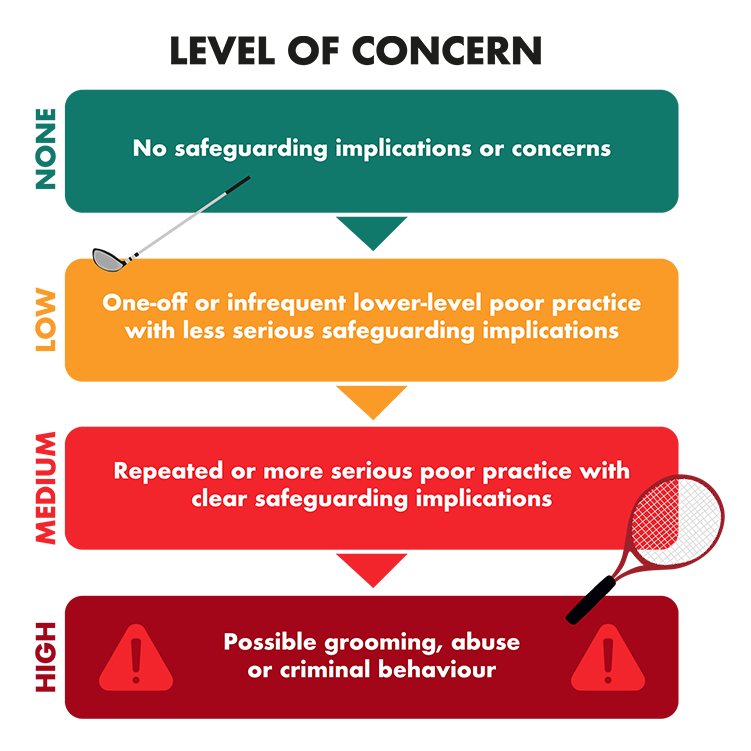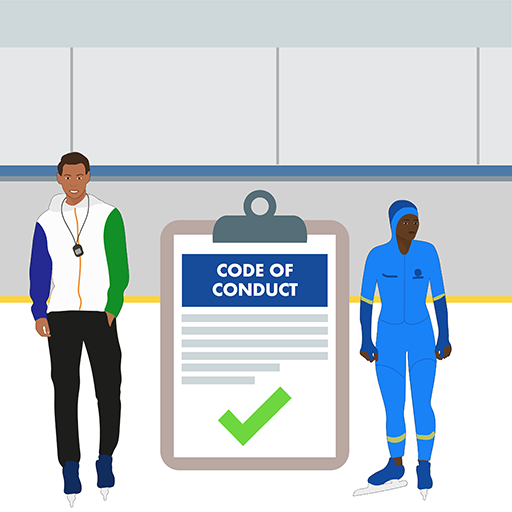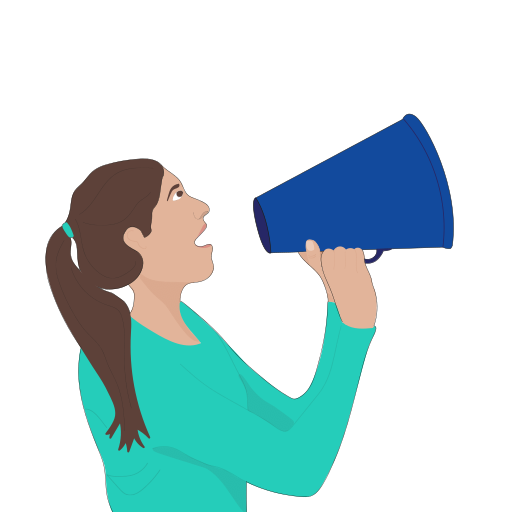Use 'Print preview' to check the number of pages and printer settings.
Print functionality varies between browsers.
Printable page generated Sunday, 23 November 2025, 9:33 AM
Session 3 Understanding and recognising the grooming process
3.1 Introduction
In this session, you will explore what is meant by grooming for sexual abuse.
Learning outcomes
In this session, you will:
Identify how and why abusers groom children and others. |
Understand the important part that grooming plays in the abuse of children and other vulnerable people. |
Consider what measures can be put in place to prevent it. |
You should note that grooming can lead to different forms of abuse, such as online grooming forming a key element in sports corruption, match manipulation, or financial exploitation of athletes. This session focuses solely on grooming for sexual abuse.
This session focuses on grooming for sexual abuse, and learners may find some of the content difficult and upsetting. Please make yourself aware of the |
3.2 Applying your learning: comment
Task 1
Identify what your organisation is already doing to raise awareness about types of abuse.
Comment
You may have found that your organisation already shares a lot of information about the different forms of abuse with staff and athletes – or perhaps that it focuses on some forms of abuse and not others.
You may also have found that your organisation shares information with staff but not athletes, or vice versa. Whatever you have discovered, if you have found gaps in this information, it is important to pass this on to the Safeguarding Lead to help them address it.
3.3 What is grooming for sexual abuse?
Sexual abuse never just happens. Grooming describes the way in which individuals behave so they can access and abuse their vulnerable targets and maintain secrecy to avoid exposure.
Grooming is a process abusers use to prepare, manipulate, and control their potential victims, the victim’s support network (family or friends), colleagues (coaches, volunteers, and others) – sometimes even a whole organisation – so that they can commit the abuse and keep it undetected.
Most abusers are aware of the seriousness of what they do, and of the consequences of being caught. They therefore take great care to hide or disguise their motivations and actions.
Grooming can happen in all environments/contexts where there are potential victims, including the sporting environment. Grooming can take place anywhere, in the real or
In some countries, grooming a child for sexual abuse or other purposes is a criminal offence. Your organisation should understand what the law in your country says about grooming. |
3.4 Why is it important to understand the grooming process?
It is important for you to understand the way that many sexual abusers groom victims and others – and to be able to recognise the kinds of sports culture in which abusers can more easily operate. This will help you to prevent it happening.
It’s impossible to see inside someone’s head – to know whether they have good or bad intentions. You can’t see motivation and thoughts. However, the grooming process involves behaviours by individuals, and these are visible. You can see behaviours and act when you see unacceptable behaviour to stop it from happening. This is why it is important to include grooming behaviour in your
Let’s practise identifying the difference between someone’s behaviours and their motivating thoughts.
 Identifying behaviours and motivating thoughts
Identifying behaviours and motivating thoughts
Look at each statement in the tile below and move it to the appropriate box – Behaviours or Motivating thoughts.
Comment
Were you able to correctly identify which were behaviours and which were thoughts? You need to focus on individuals’ behaviour as a way to prevent or intervene in the grooming process.
3.5 A model of the grooming process
Research has helped to identify a number of phases in the grooming process for sexual purposes.
One model below breaks the process down into six main stages (Hartill, 2018):
- Stage 1: Targeting the victim
- Stage 2: Gaining trust
- Stage 3: Meeting a victim’s need
- Stage 4: Isolating the victim
- Stage 5: Sexualising the relationship
- Stage 6: Maintaining control and secrecy
Next, you will examine this process in more detail.
3.6 Grooming potential victims: Stages 1–6 explained
Abusers will first identify a target (Stage 1). They identify those having some sort of vulnerability or need that the abuser can take advantage of.
These may be the younger, quieter, less confident athletes; children with disability; those who find it harder to socialise; or whose background includes neglect or other trauma; children who identify as LGBTQ+; those seen as ‘troubled’ or ‘naughty’ children who others see as a problem; children without parents or close family; those who feel insecure about their bodies or who crave adult attention.
 Stages 2–6 of the grooming process
Stages 2–6 of the grooming process
Take a look at the following headings that describe the next 5 stages of the grooming process. For each heading match it to the description that best applies.
3.7 How children in sport can be particularly vulnerable to grooming and abuse
Sport provides very specific opportunities for abusers to groom children.
On an elite athlete pathway, there are many children (and parents) who see making it to the top of their sport as their ultimate goal – and this desire can be exploited. The pressure – even desperation – to achieve success means that many young athletes are already more vulnerable to all forms of abuse and exploitation.
This is even more significant for children who have lived difficult lives – the dream of a ‘way out’ makes them even more vulnerable.
 The power of a sporting dream
The power of a sporting dream
Trigger warning
Listen to this testimony from Paul Stewart, a former professional footballer.
Consider the aspects of
Transcript
PAUL STEWART: These individuals are perceived as dream makers. They tell parents, they tell the child, that they can make them realise their dream. And whether that’s being a footballer, being an athlete, being a swimmer, they make promises of dreams and they actually say that they can help you fulfil your dream. And that’s the power that they have. I do then believe that these individuals hold the power in the palm of their hand to give and take away the only thing you ever wanted to be. And in my case, it was being a footballer.
Comment
The environment and dynamics in sport described here are exactly those that offer opportunities for grooming and abuse. Someone who seems to hold the key to an athlete getting to the top is in an incredibly powerful position over a child and their parent. In this way, sport offers specific opportunities for abusers to groom, abuse their position, and harm children. This may lead to sexual abuse, or to forcing children into other harmful actions, such as match fixing or doping.
In the next section, you consider why some children involved in sport are at greater risk of being targeted by abusers.
3.8 Why do abusers target vulnerable children?
It is important to understand why abusers tend to target certain groups of children more than others. In the next activity, we use the example of vulnerable children.
 Why do abusers target more vulnerable children?
Why do abusers target more vulnerable children?
Why do you think an abuser would choose to target more vulnerable children? Match the headings to the list of reasons given by abusers themselves.
Comment
Although any child is vulnerable to grooming and abuse, there are reasons why abusers may target some children more than others. Understanding this helps you to identify grooming behaviours and take steps to prevent or respond to them.
3.9 Grooming others: adults, carers, parents, organisations, and communities
In order to avoid detection and reduce the chances of any disclosure being believed, abusers will also groom those around and closest to the child.
 Who might an abuser groom?
Who might an abuser groom?
Imagine that in a community sports club, one of the medics has targeted a boy for grooming. Think about the sports club environment and the other adults involved.
Your task is to identify who else the medic may need to groom to reduce the chances of suspicions arising about his behaviour? This could be anyone who might be able to identify the grooming behaviour.
Make notes below and then compare them to our ideas.
Comment
Here are the ideas we had:
| Teammates or other children outside the sporting context. |
| Child’s parents. |
| Other children’s parents. |
| Colleagues – coaches, officials. |
| The volunteers, and other medics. |
| Club managers. |
| Club Safeguarding Lead. |
| Other support staff like cleaners, bus drivers, and grounds people. |
All these people are individuals who the child may tell, or who may spot and report worrying signs about the medic’s behaviour. He will therefore take steps to try to reassure them about his motivation – and manipulate them all into viewing him as a ‘good guy’ whose behaviour does not raise concerns.
Why do abusers groom people around the child, clubs, and organisations?
You have learned that abusers groom parents (and often the wider family), other potentially protective adults around the child – and sometimes the sports club, organisation, or even the community. They do this to create an image, position, and/or reputation for themselves which is so positive and powerful that it allows them to abuse children. Grooming will:
- Convince others that their intentions towards children are totally positive – and that they would never harm a child.
- Allow them to undermine, bend, or break rules with no action taken. Place them above any suspicion.
- Allow them to manipulate their contact with particular children, excluding other adults and children – allowing them to spend time alone with their victims.
- Establish enough power – position and/or charisma – to intimidate children and adults with concerns and reduce the likelihood of allegations being made or taken seriously should they arise.
| An abuser’s image |
A groomer wants an image and reputation that means anyone hearing any allegation will react with disbelief. This is one way that groomers try to make sure they are not stopped from abusing and is all part of the manipulative way that they operate. |
3.10 Patterns and repeated behaviours
Your judgement about whether someone’s behaviour is concerning – for example, if it could indicate grooming – should not be fixed. When additional information is available, you should review and, if necessary, revise your conclusions.
 Consider how your perception of concern can be altered
Consider how your perception of concern can be altered
Read the following pieces of information. After each one, slide the scale to indicate your level of concern. As you do this, think about what factors have influenced your answer.
You should not wait until concerns escalate to the ‘high’ level. You should take action immediately when the first breaches of the code of conduct happen and share any concerns you have about someone’s behaviour. This is what makes codes of conduct so useful. |
In the next section, you find out how a code of conduct can help address grooming.
3.11 Using a code of conduct to prevent or detect grooming
Codes of conduct are an important way to prevent grooming or take action if it happens. They spell out all the behaviour that is not allowed in your organisation. They should deter abusers from:
- Giving gifts to athletes.
- Demonstrating favouritism.
- Promoting a culture of secrecy.
- Providing lifts for athletes in private cars.
- Inviting athletes to their home.
- Spending time alone with athletes away from others.
- Using social media or e-communications to engage with athletes privately.
- Sharing hotel or other residential bedrooms with athletes at events or on tour.
- Taking athletes away on private trips (not organisation-approved trips).
If these behaviours are included in a code of conduct, and the code of conduct applies to everyone in your organisation, they reduce the opportunities to groom because they make it clear what isn’t acceptable.
In Session 5, you explore codes of conduct in more detail.
3.12 What steps can you take to combat grooming?
In addition to strengthening your code of conduct, it is possible for your organisation to take steps to combat grooming.
 Basic actions every organisation can take
Basic actions every organisation can take
Below you will find a summary of five types of basic actions organisations can take to address the dangers of grooming. For each description, use the drop-down menu to match the heading that summarises the action.
By understanding the signs of grooming behaviour and taking steps in your organisation to combat grooming, you can play a role in reducing the risk of abuse. |
3.13 Summary of Session 3
| The main learning and messages from this session are: |
|
When you are ready, move on to Session 4 Understanding risk, where you discover more about understanding and assessing risk.






